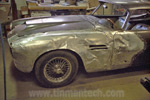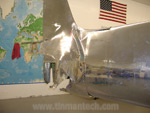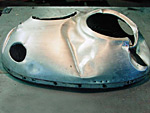Repairing Aluminum: Straightening Tempered Aluminum Sheets
Repairing Aluminum Part 2
Straightening Tempered Aluminum Sheets
Straightening Tempered Aluminum Sheets
KEY WORDS:-stretching
-hot shrinking annealing
-metal finishing
-cold shrinking
-hot work
-planishing
As with a steel part, a good start is made by pushing or bumping out with the appropriately contoured tool. However, hammering should be done judiciously and with caution. The objective is to work smart and not so hard. With each blow of the hammer, spoon or slapper rings on the dolly, stretching occurs (Fig. 1). For this reason, care should be taken to work off the dolly as much as possible (Fig. 2). Bumping and lifting to a roughly correct contour will prevent excessive stretching. Use the properly contoured tool for the push and bump (Figs. 3~). Work until the springy resistance prevents metal movement. Now, find the high spot and get ready to shrink.
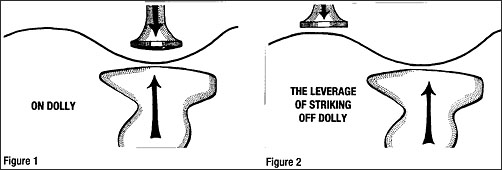
Since cold shrinking is almost impossible on tempered aluminum, we will discuss hot shrinking. On difficult areas, heating the area to temporarily reduce properties can mean the difference between success and failure (see heating guidelines that follow).

The following shrinking method is easier and simpler on aluminum than on steel. Remember, stretching is easy. Just hammer too hard, push too hard, or hammer "on dolly" too much and you'll get bags of stretched metal. Shrinking is more difficult. It's a "black art" that becomes easier with practice. To shrink, first follow these two guidelines:
Choose the right contour, size and weight hammer, spoon or slapper and dolly. Most hammers have large (11/2 in. diameter) or medium (11/4 in. diameter) faces, flat or medium crowns, and are heavy ((1/16 oz.) or medium (8-10 oz.) in weight. Two additional striking tools are the traditional slapper and spoon (Figs. 7 and 8). The spoon, driven by a hammer, spreads the force over a large area, leaves few if any marks and works well on relatively flat surfaces (Fig. 8-A). By itself, the spoon hits lightly and evenly, shrinking large gentle high spots very effectively (Fig. 8-B).
Use mechanical advantage. The trick to quick, efficient shrinking and straightening is mechanical advantage. In Figure 9, the mechanical advantage of off-dolly work is seen as the simple leverage of working one low spot against a high one.
However, in Figure 10, a greater advantage is gained with the use of a slapper. By covering two high spots at
once, the slapper brings up the low more precisely.
(see Slappers available from TM Technologies)

Use a #2 tip with the pressure regulators set to 5 pounds and 5 pounds, respectively. Adjust the flame to
slightly soft or reducing, and heat rapidly to the desired temperature. Working quickly, bump the high
area down with the hammer while supporting the neighboring low area with the dolly (Fig.
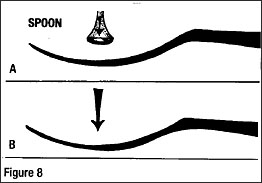
Note: I have routinely reduced bulges higher than one full inch in 5052 H34, 6061 T6, and 3003 H14 by this method.
This warm-and-bump system may be used again and again until the proper contour is achieved. A wooden dolly
block may be employed in more critical situations where a greater downward driving force is needed for a
very specific change in shape. The wood absorbs hammer shock rather than reflecting it and
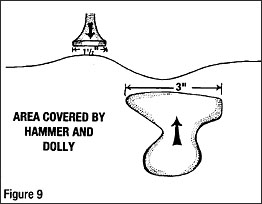
Over the past 50 years, many roughfaced tools have been sold as shrinking hammers, but none do any more than limit the stretch to some degree at the cost of beating up the work. The two magic tools for shrinking are practice and careful observation.
The more difficult shrinks to pull will be those of subtle definition (low mechanical advantage) and
thicker, less workable alloys. There is hope, however, even if welding is necessary. Persistence with
careful heating and quick hammer-mg will
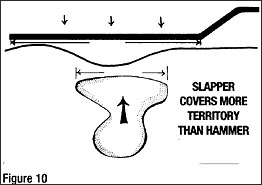
Planishing is the traditional term used for the process of smoothing a rough panel to a finished condition simply by hammering (or rolling). For centuries, metalsmiths the world over have worked sheets of gold, silver, pewter, brass, bronze, iron, and steel to polished condition (with very little filing or sanding) by planishing.
Note: Metal finishing, also traditional, refers to the process of filing and sanding the work. In the context of autobody work, metal finishing would bring the planished piece to a degree of finish appropriate for painting, plating or polishing.

